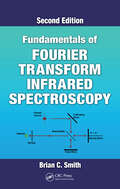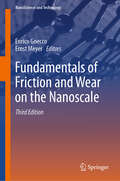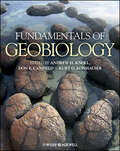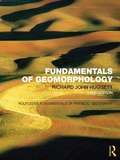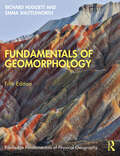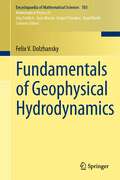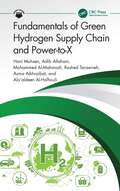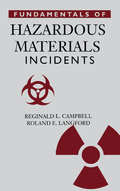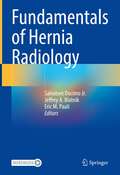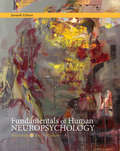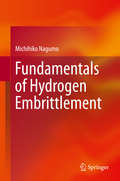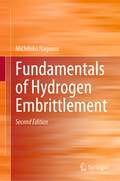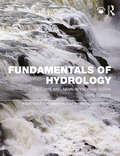- Table View
- List View
Fundamentals of Fourier Transform Infrared Spectroscopy
by Brian C. SmithReflecting the myriad changes and advancements in the technologies involved in FTIR, particularly the development of diamond ATRs, this second edition of Fundamentals of Fourier Transform Infrared Spectroscopy has been extensively rewritten and expanded to include new topics and figures as well as updates of existing chapters. Designed for those ne
Fundamentals of Fracture Mechanics
by Tribikram KunduAlmost all books available on fracture mechanics cover the majority of topics presented in this book, and often much, much more. While great as references, this makes teaching from them more difficult because the materials are not typically presented in the order that most professors cover them in their lectures and more than half the information p
Fundamentals of Fragrance Chemistry
by Charles S. SellThis textbook provides a simplified introduction into organic chemistry, which includes separation techniques and analytical methodologies. It continues to discuss the structure of perfume creation with respect to the many reactive ingredients in consumer products and how to formulate effective and long lasting fragrances.
Fundamentals of Friction and Wear on the Nanoscale (NanoScience and Technology)
by Enrico Gnecco Ernst MeyerThis book offers a comprehensive review on the latest developments in the field of nanotribology. With contributed chapters covering instrumental aspects, theoretical models, and selected experimental results, this book provides a broad overview of the fundamental issues currently being investigated in the field. The updated third edition includes new topics such as molecular tribology, multiscale structural lubricity, tribofilm growth, nanoscale friction in liquids, and nanotribology at insect-plant interfaces. Written by a highly qualified group of international experts, this book aims to be a key reference on the subject for the next five to ten years, highlighting the importance of understanding the atomistic origins of friction and wear in everyday life and in technical applications.
Fundamentals of Gas Dynamics
by Mrinal KaushikThis textbook for courses in gas dynamics will be of interest to students and teachers in aerospace and mechanical engineering disciplines. It provides an in-depth explanation of compressible flows and ties together various concepts to build an understanding of the fundamentals of gas dynamics. The book is written in an easy to understand manner, with pedagogical aids such as chapter overviews, summaries, and descriptive and objective questions to help students evaluate their progress. The book contains example problems as well as end-of-chapter exercises. Detailed bibliographies are included at the end of each chapter to provide students with further resources. The book can be used as a core text in engineering coursework and also in professional development courses.
Fundamentals of Gas Dynamics (Ane/athena Bks.)
by V. BabuThis textbook on Fundamentals of Gas Dynamics will help students with a background in mechanical and/or aerospace engineering and practicing engineers working in the areas of aerospace propulsion and gas dynamics by providing a rigorous examination of most practical engineering problems. The book focuses both on the basics and more complex topics such as quasi one dimensional flows, oblique shock waves, Prandtl Meyer flow, flow of steam through nozzles, etc. End of chapter problems, solved illustrations and exercise problems are presented throughout the book to augment learning.^
Fundamentals of Geobiology
by Andrew H. Knoll Kurt O. Konhauser Don E. Canfield2012 PROSE Award, Earth Science: Honorable Mention For more than fifty years scientists have been concerned with the interrelationships of Earth and life. Over the past decade, however, geobiology, the name given to this interdisciplinary endeavour, has emerged as an exciting and rapidly expanding field, fuelled by advances in molecular phylogeny, a new microbial ecology made possible by the molecular revolution, increasingly sophisticated new techniques for imaging and determining chemical compositions of solids on nanometer scales, the development of non-traditional stable isotope analyses, Earth systems science and Earth system history, and accelerating exploration of other planets within and beyond our solar system.Geobiology has many faces: there is the microbial weathering of minerals, bacterial and skeletal biomineralization, the roles of autotrophic and heterotrophic metabolisms in elemental cycling, the redox history in the oceans and its relationship to evolution and the origin of life itself..This book is the first to set out a coherent set of principles that underpin geobiology, and will act as a foundational text that will speed the dissemination of those principles. The chapters have been carefully chosen to provide intellectually rich but concise summaries of key topics, and each has been written by one or more of the leading scientists in that field..Fundamentals of Geobiology is aimed at advanced undergraduates and graduates in the Earth and biological sciences, and to the growing number of scientists worldwide who have an interest in this burgeoning new discipline.Additional resources for this book can be found at: http://www.wiley.com/go/knoll/geobiology.
Fundamentals of Geomorphology
by Richard John HuggettThis extensively revised, restructured, and updated edition continues to present an engaging and comprehensive introduction to the subject, exploring the world's landforms from a broad systems perspective. It covers the basics of Earth surface forms and processes, while reflecting on the latest developments in the field. Fundamentals of Geomorphology begins with a consideration of the nature of geomorphology, process and form, history, and geomorphic systems, and moves on to discuss: structure: structural landforms associated with plate tectonics and those associated with volcanoes, impact craters, and folds, faults, and joints process and form: landforms resulting from, or influenced by, the exogenic agencies of weathering, running water, flowing ice and meltwater, ground ice and frost, the wind, and the sea; landforms developed on limestone; and landscape evolution, a discussion of ancient landforms, including palaeosurfaces, stagnant landscape features, and evolutionary aspects of landscape change. This third edition has been fully updated to include a clearer initial explanation of the nature of geomorphology, of land surface process and form, and of land-surface change over different timescales. The text has been restructured to incorporate information on geomorphic materials and processes at more suitable points in the book. Finally, historical geomorphology has been integrated throughout the text to reflect the importance of history in all aspects of geomorphology. Fundamentals of Geomorphology provides a stimulating and innovative perspective on the key topics and debates within the field of geomorphology. Written in an accessible and lively manner, it includes guides to further reading, chapter summaries, and an extensive glossary of key terms. The book is also illustrated throughout with over 200 informative diagrams and attractive photographs, all in colour.
Fundamentals of Geomorphology (Routledge Fundamentals of Physical Geography)
by Richard Huggett Emma ShuttleworthThis revised and updated edition continues to provide a comprehensive introduction to the subject, exploring the world’s landforms from a broad systems perspective. It covers the basics of Earth surface forms and processes, while reflecting on the latest developments in the field. Fundamentals of Geomorphology begins with a consideration of the nature of geomorphology, including its relation to society, process and form, history, and geomorphic systems, and moves on to discuss: • Structure: structural landforms associated with plate tectonics and those associated with volcanoes, and folds, faults, and joints. • Process and form: landforms resulting from, or influenced by, the exogenic agencies of weathering, running water, flowing ice and meltwater, ground ice and frost, the wind, and the sea; landforms developed on limestone; extraterrestrial landforms; and landscape evolution, a discussion of ancient landforms. Fundamentals of Geomorphology provides a stimulating and innovative perspective on the key topics and debates within the field of geomorphology. Written in an accessible and lively manner, it includes guides to further reading, chapter summaries, and an extensive glossary of key terms. The book is also illustrated throughout with over 200 informative diagrams and attractive photographs, all in colour. It is supported by online resources for students and instructors.
Fundamentals of Geophysical Hydrodynamics
by Boris Khesin E. B. Gledzer Felix V. Dolzhansky A. E. GledzerThis newly-translated book takes the reader from the basic principles and conservation laws of hydrodynamics to the description of general atmospheric circulation. Among the topics covered are the Kelvin, Ertel and Rossby-Obukhov invariants, quasi-geostrophic equation, thermal wind, singular Helmholtz vortices, derivation of the Navier-Stokes equation, Kolmogorov's flow, hydrodynamic stability, and geophysical boundary layers. Generalizing V. Arnold's approach to hydrodynamics, the author ingeniously brings in an analogy of Coriolis forces acting on fluid with motion of the Euler heavy top and shows how this is used in the analysis of general atmospheric circulation. This book is based on popular graduate and undergraduate courses given by F.V.Dolzhansky at the Moscow Institute of Physics and Technology, and is the result of the author's highly acclaimed work in Moscow's Laboratory of Geophysical Hydrodynamics. Each chapter is full of examples and figures, exercises and hints, motivating and illustrating both theoretical and experimental results. The exposition is comprehensive yet user-friendly in engaging and exploring the broad range of topics for students and researchers in mathematics, physics, meteorology and engineering.
Fundamentals of Geothermal Heat Pump Systems: Design and Application
by Louis LamarcheFundamentals of Geothermal Heat Pump Systems: Design and Application is written for upper-level undergraduate and graduate courses in renewable energy and heat transfer. This classroom-tested text covers ground heat exchanger modeling, secondary loop ground-source system design, pumping energy, thermal response testing, commercial building applications, and horizontal and groundwater ground heat exchangers. The book is oriented to practical applications, including the economic analysis of ground source heat pump (GSHP) systems, but more theoretical sections are provided covering research-related geothermal applications. Chapters on heat transfer fundamentals and heat pump concepts are included for readers less familiar with thermal engineering concepts. A chapter covering the economic analysis of GSHP systems is also included. All of the examples and problems in the book are solved using the open-source Python programming language.The book will provide students in geothermal energy courses with a solid understanding of the subject. It will also be a valuable reference for professionals working in the field of renewable energy.
Fundamentals of Green Hydrogen Supply Chain and Power-to-X
by Hani Muhsen Adib Allaham Mohammed Al-Mahmodi Rashed Tarawneh Asma Alkhraibat Ala’aldeen Al-HalhouliThis book offers an engaging introduction to green hydrogen and its role in changing the global energy landscape. It explains theoretical and practical aspects of the green hydrogen supply chain, including production, storage, transportation, and utilization, and explores the techno-economic aspects relevant to each stage. Through hands-on examples, readers understand how green hydrogen can be implemented across various applications. It explains Power-to-X technologies, which enable the conversion of green hydrogen into eco-friendly fuels and chemical feedstocks. Designed for students and researchers, this book simplifies complex concepts and provides a comprehensive understanding of green hydrogen's benefits.Key Features: Covers end-to-end the green hydrogen and Power-to-X technologies (PtX) supply chain. Provides a holistic and integrated approach of theoretical and practical knowledge utilizing examples and various case studies from around the world. Demonstrates the global potential of green hydrogen with sector-specific applications and case studies. Includes cutting-edge and recent developments in the green hydrogen landscape with clear visuals and technical explanations. Discusses forward-looking evaluations of Power-to-X technologies, hydrogen safety, and green hydrogen techno-economic aspects. Written in simple yet detailed language for a wide spectrum of readers. Tests readers' comprehension of the topics covered with self-assessment questions at the end of each chapter. This textbook is an excellent foundational text for university students and researchers in renewable energy engineering, energy systems engineering, chemical, environmental, and mechanical engineering, and sustainable development. It is also valuable to professionals in energy, heavy industries, and the chemical and pharmaceutical sectors, and policymakers with a focus on innovative clean, renewable energy.
Fundamentals of Guided-Wave Optoelectronic Devices
by William S. C. ChangOptoelectronic guided-wave devices are used in a wide range of optical fiber communication and optoelectronic systems. In such networks, the electrical and the optical characteristics of guided-wave devices, and the interplay between them, have a profound effect on system design and overall performance. Uniquely, this book combines both the optical and electrical behavior of guided-wave optoelectronic devices so that the interwoven properties, including interconnections to external components, are easily understood. It provides the key concepts and analytical techniques that readers can apply to current and future devices. It also presents the impact of material properties on guided-wave devices, and emphasizes the importance of time-dependent interactions between electrical and optical signals. This is an ideal reference for graduate students and researchers in electrical engineering and applied physics departments, as well as practitioners in the optoelectronics industry.
Fundamentals of Hazardous Materials Incidents
by Reginald Campbell R. Everett LangfordThis book evolved from the course developed at the U.S. Department of Labor's National Mine, Health, and Safety Academy to develop the legislation that eventually became 29 CFR 1910.120.Fundamentals of Hazardous Materials Incidents offers the reader a basic understanding of the principles involved in toxicology, federal regulations, respiratory protection, personal protective equipment, radiation, environmental considerations, industrial hygiene sampling, site safety, and chemically resistant suits. Thousands of people have been trained using this manual, now revised and available for the first time in hardcover format. The book is essential for identifying potential problems at hazardous waste sites, covers diverse topics throughout the area of hazardous materials response, and is ideal for training courses to meet 29 CFR 1910.120 requirements. Quantity discounts available.
Fundamentals of Hazardous Waste Site Remediation
by Kathleen SellersEvery practicing environmental engineer should already have a firm grasp on the basics of hazardous waste site remediation-the key to confronting a site problem, and devising an effective solution.Since their original introduction to remediation, technology has kept moving ahead with new ideas and procedures. Fundamentals of Hazardous Waste Site Remediation gives environmental professionals immediate access to the basics of the trade, along with information about recent advancements.This comprehensive overview examines the basics of such areas as hazardous materials chemistry, hydrogeology, reaction engineering, and clean-up level development. A chapter on Cost Estimating will be of particular interest to specialists, in light of recent concerns about the increased costs of remediation. After reading each chapter, test your new knowledge with the review problems.As a refresher guide for career environmental engineers, or a helpful tool to newcomers in the field, Fundamentals of Hazardous Waste Site Remediation is a valuable resource for longtime professionals and newcomers alike.
Fundamentals of Heat Transfer: An Interdisciplinary Analytical Approach
by Moghtada Mobedi Gamze Gediz IlisThis book demonstrates the analytical solution of fundamental problems in heat transfer which covers conduction, convection, and radiation heat transfer. The analytical solution of heat transfer problems is described in a simple way which is easy to understand. This book also provides competence of solving fundamental heat transfer problems by analytical method which is particularly important to gain a strong background on heat transfer. The book is an interdisciplinary heat transfer book which is useful for all academicians and students from different disciplines with different levels of mathematical knowledge. The book can be used as a core or supplementary textbook in undergraduate and graduate bridge courses. Furthermore, it is suitable for professional and vocational coursework for technology and engineering professionals.
Fundamentals of Helicopter Dynamics
by C. VenkatesanHelicopter Dynamics Introduced in an Organized and Systematic MannerA result of lecture notes for a graduate-level introductory course as well as the culmination of a series of lectures given to designers, engineers, operators, users, and researchers, Fundamentals of Helicopter Dynamics provides a fundamental understanding and a thorough overview o
Fundamentals of Hernia Radiology
by Jeffrey A. Blatnik Eric M. Pauli Salvatore Docimo Jr.This book offers a complete focus on the radiographic analysis of the abdominal wall and hernias. An estimated 20 million hernias are repaired annually throughout the world. As the technology utilized to complete hernia repairs becomes more complex, surgeons are required to have a more thorough understanding of the radiographic anatomy and diagnostic modalities used to evaluate hernias. Furthermore, the amount that now goes into the preoperative planning of hernias for complex repairs (such robotic and open transversus abdominis muscle release procedures) requires an understanding of radiology and the ability to identify nuances of anatomy offered by the imaging. The use of mesh and extent of re-do hernia repairs has also complicated radiographic evaluation of hernias. The text is a comprehensive review of abdominal wall imaging broken down into individual types of hernia. Each hernia type is discussed with consideration to the best type of imaging evaluation, unique radiographic findings and considerations prior to repair. Representative images, diagrams and videos are used to point out anatomy and features of the hernia. This text offers the first-of-its-kind standardized approach to evaluating hernias radiographically. Most importantly, each hernia and chapter is approached with the surgeon in mind, meaning, authors explain the radiology based on anatomy and with a plan for surgical repair on the horizon. Select chapters include illuminating videos to give context to the text. This is an ideal guide for practicing surgeons and trainees treating patients with hernias.
Fundamentals of Human Embryology: Student Manual (second edition)
by John Allan Beverley KramerThe Fundamentals of Human Embryology covers embryonic development, with a unique focus on adult anatomy. Its goal is to impart to students a comprehensive overview of how the human embryo forms, not only as a basis for the student of human anatomy, but also as a link to abnormalities they may encounter in their clinical careers. Extensively illustrated with labeled line drawings, now enlarged for better visibility, this concise manual will meet the needs of both undergraduate and postgraduate students in the Human Sciences.Special features include:• Separate chapters on the neural crest, the skull and osteogenesis• In-depth coverage of head and neck embryology, including the development of the tooth, for students of dentistry, and speech and audiologyIn this Second Edition of the manual at the request of students and teachers, the authors have made the following changes:• Increased the size of the diagrams• Revised the text to comply with the Federative International Committee on Anatomical Terminology changes to the Terminologia Embryologica• Altered the sequencing of some topics to allow the development to flow more logically• Included an appendix of coloured photographs of congenital abnormalities to help students form a more realistic idea of developmental abnormalities.
Fundamentals of Human Neuropsychology
by Bryan Kolb Ian Q. WhishawWritten by two masterful researchers and educators, Fundamentals of Human Neuropsychology was the first textbook to introduce students to the scientific exploration of human behavior from a neuroscientist's perspective. With this updated edition, Bryan Kolb and Ian Whishaw again take students to the very forefront of one of the most eventful and impactful areas of scientific inquiry today, making an extraordinary amount of recent research and the real-world impact of those discoveries fascinating and accessible.
Fundamentals of Human Physiology
by Giovanni CavagnaThis textbook explores the fundamental qualitative and quantitative aspects of human physiology. It approaches biological and physiological processes and phenomena from a quantitative perspective, revealing how physiological problems can be mathematically formulated starting from simple laws of physics. The book addresses a broad range of topics, including: the statics and dynamics of circulation; muscle and sarcomere force-length and force-velocity relations, together with their mechanisms and functional consequences; subdivisions and meaning of the heat produced by muscle; locomotion, statics and dynamics of respiration; diffusion of gases and acid base equilibrium; phonation; general functions of the kidney and of the different sections of the nephron; changes in clearance with a substance’s plasmatic concentration; pH regulation and the kidney; Donnan’s equilibrium and its consequences; and the Nernst equation. The book offers the ideal learning resource for students of human physiology courses in medicine and biomedicine, as well as biomedical engineering and biophysics graduate students. An elementary grasp of mathematics and physics is sufficient to understand the content.
Fundamentals of Human Physiology (Fourth Edition)
by Lauralee SherwoodThis edition provides scientifically sound coverage of the fundamental concepts of physiology and incorporates pedagogical features that make it interesting and comprehensible.
Fundamentals of Hydrogen Embrittlement
by Michihiko NagumoThis book is the first comprehensive treatment ofhydrogen embrittlement of metallic materials, mainly of steels. The subject isincreasingly important with regard to recent requirements for hydrogen energyequipment. Recent progress in revealing the nature of hydrogen embrittlement isremarkable, and this book provides students and researchers engaging inhydrogen problems with a comprehensive view of hydrogen embrittlement coveringbasic behaviors of hydrogen in materials and their various manifestations in degradation of mechanicalproperties. Previous studies are critically reviewed and recent advancesincluding new ideas on the mechanism of embrittlement are presented. Emphasesare put on experimental facts, but their meanings rather than phenomenologicalappearance are given particular attention. Experiments are noted on adoptedconditions since the operating mechanism of hydrogen might differ by materialsand environments. For theories, assumptions and premises employed are noted soas to examine their versatility. Because of the interdisciplinary nature of thesubject, brief descriptions of fundamental ideas are presented when necessary.
Fundamentals of Hydrogen Embrittlement
by Michihiko NagumoThis book is the second edition of the one originally published in 2016, as the first comprehensive treatment on the fundamentals of hydrogen embrittlement of metallic materials, mainly steel. The book provides students and researchers engaging in hydrogen problems with a unified view of the subject. Establishing reliable principles for materials design against hydrogen embrittlement and assessing their performance are recent urgent industrial needs in developing high-strength steel for hydrogen energy equipment and weight-reducing vehicles. The interdisciplinary nature of the subject, covering metal physics, materials science, and mechanics of fracture, has disturbed a profound understanding of the problem. In this book, previous studies are critically reviewed, and supplemental descriptions of fundamental ideas are presented when necessary. Emphasis is placed on experimental facts, with particular attention to their implication rather than phenomenological appearance. The adopted experimental conditions are also noted since the operating mechanism of hydrogen might differ by material and environment. For theories, employed assumptions and premises are noted to examine their versatility. Progress in the past decade in experimental and theoretical tools is remarkable and has nearly unveiled characteristic features of hydrogen embrittlement. Proposed models have almost covered feasible aspects of the function of hydrogen. This second edition has enriched the contents with recent crucial findings. Chapters on the manifestation of embrittlement in the deterioration of mechanical properties and microscopic features are reorganized, and the description is revised for the convenience of readers’ systematic understanding. A new chapter is created for delayed fracture in atmospheric environments as a conclusive subject of critical ideas presented in this book.
Fundamentals of Hydrology (Routledge Fundamentals of Physical Geography)
by Tim DavieThe third edition of Fundamentals of Hydrology provides an absorbing and comprehensive introduction to the understanding of how fresh water moves on and around the planet and how humans affect and manage the freshwater resources available to them. The book consists of three parts, each of fundamental importance in the understanding of hydrology: The first section deals with processes within the hydrological cycle, our understanding of them, and how to measure and estimate the amount of water within each process. This also includes an analysis of how each process impacts upon water quality issues. The second section is concerned with the measurement and analytical assessment of important hydrological parameters such as streamflow and water quality. It describes analytical and modelling techniques used by practising hydrologists in the assessment of water resources. The final section of the book draws together the first two parts to discuss the management of freshwater with respect to both water quality and quantity in a changing world. Fundamentals of Hydrology is a lively and accessible introduction to the study of hydrology at university level. It gives undergraduates a thorough understanding of hydrological processes, knowledge of the techniques used to assess water resources, and an up-to-date overview of water resource management. Throughout the text, examples and case studies from all around the world are used to clearly explain ideas and techniques. Essay questions, guides to further reading, and website links are also included.
